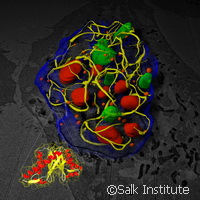The common cold, a potential ally in the fight against cancer
Scientists may have found a surprising ally in the fight against cancer - the common cold. This finding was made by a team of scientists at the Salk Institute for Biological Studies in California; they believe that if the properties of a specific type of cold virus, the adenovirus, can be mimicked, then new cancer therapies can be developed. Their findings have been published in the journal Cell. Adenoviruses are a group of viruses that commonly attack the tissue linings of the respiratory tract, eyes, intestines and urinary tract. They are also the most common cause for diarrhoea. What makes this virus stand out is its ability to take over a cell's molecular machinery, including large cellular machines involved in growth, replication and cancer suppression. What the Salk scientists have successfully achieved is to identify their construction, having found that they bind together into polymers, a chemical compound, to form a three-dimensional web inside cells. These then trap and overpower cells involved in growth and cancer suppression. 'Cancer was once a black box,' says Clodagh O'Shea, who led the study and is an assistant professor in Salk's Molecular and Cell Biology Laboratory. 'The key that opened that box was revealing the interactions between small DNA tumour virus proteins and cellular tumour suppressor complexes. But without knowing the structure of the proteins they use to attack cells, we were at a loss for how these tiny weapons win out over much larger tumour suppressors.' O'Shea's team focused their efforts on E4-ORF3 - a cancer-causing protein encoded by adenovirus. This protein is known to prevent the p53 tumour suppressor protein from binding to its target genes. The p53 protein is referred to as the 'guardian of the genome', as it normally suppresses tumours by causing cells with DNA damage to self-destruct. People diagnosed with cancer often have an inactivated p53 tumour suppressor pathway, which allows cancer cells to escape normal growth controls. When p53 is inactivated, the E4-ORF3 protein enables adenovirus replication in infected human cells to go unchecked. O'Shea had previously discovered that E4-ORF3 clears the way for adenovirus to proliferate by deactivating genes that help the cell defend itself against the virus. 'It literally creates zip files of p53 target genes by compressing them until they can no longer be read,' she explains. Horng Ou, a postdoctoral researcher in O'Shea's laboratory, explains the properties of E4-ORF3: 'It doesn't resemble any known proteins that assemble polymers or that function in cellular tumour suppressor pathways. 'Most cellular polymers and filaments form uniform, rigid chains. But E4-ORF3 is the virus's Swiss army knife -- it assembles into something that is highly versatile. It has the ability to build itself into all sorts of different shapes and sizes that can capture and deactivate the many defences of a host cell.' The team of scientists used new techniques to reveal the ultrastructure of the polymer that E4-ORF3 assembles in the nucleus; up until now these ultrastructures had proven to be elusive as they are effectively invisible using conventional electron microscopy. 'What you see is the E4-ORF3 polymer bending and weaving and twisting its way through the nucleus,' O'Shea says. 'It does appear to have a single repeating pattern and creates a matrix that captures several different tumour suppressors and silences p53 target genes.' The researchers believe that their findings may help scientists develop small molecules capable of destroying tumours by binding and disrupting the cellular components that allow cancer cells to grow and spread. Increasing our understanding of how viruses overcome healthy cells may also help scientists engineer tumour-busting viruses, which offer a new and potentially self-perpetuating cancer therapy. Viruses modified in this manner would destroy only cancer cells, because they could only replicate in cells in which the p53 tumour suppressor has been inactivated. When a cancer cell is destroyed it would release additional copies of the engineered viruses, which in turn would seek out and kill remaining cancer cells that have spread throughout the body.For more information, please visit:Salk Institute for Biological Studies:http://www.salk.edu/Cell:http://www.cell.com/
Countries
United States

